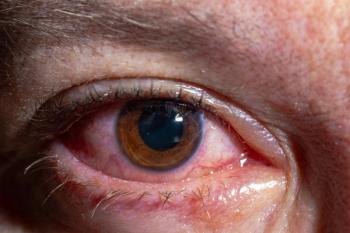
A Post-ASRS 2025 Conversation With Charles C. Wykoff, M.D., Ph.D.
Wykoff discussed treating geographic atrophy in patients with wet age-related macular degeneration and his presentation of the results of the COAST trial that was halted earlier this year.
We caught up with Charles C. Wykoff, M.D., Ph.D., after
What was one of the main takeaways from the ASRS 2025 meeting?
There continues to be an unmet need for new therapies for geographic atrophy [GA], and there is interest — and even maybe excitement — in some of the medicines in development. So there are two phase 3 trials that there's a lot of hope will be successful and valuable in GA, one targeting C1q and one targeting mitochondrial biology. There's hope that one — or both — of those will be positive. And in that context, there was a lot of discussion about how to most effectively — and in the safest way — use the current anticomplement therapeutics to manage patients with GA. There was a whole session on using them in combination with patients with wet AMD [age-related macular degeneration] with anti-[vascular endothelial growth factor] VEGF therapy.
Have retina specialists settled on a particular combination, or is this sort of evolving knowledge and clinical practice?
I think it's evolving, because the phase 3 trials that led to approval of our current two anticomplement agents, pegcetacoplan [sold under the brand name Syfovre] and avacincaptad [sold under the brand name Izervay], did not include patients with concurrent wet AMD in the enrollment criteria. Now, some of the patients developed wet AMD during the study, but they did not have it at baseline. There's sort of a disconnect between the phase 3 clinical trial and how many physicians are using these medications, because some patients do have concurrent neovascular AMD and geographic atrophy.
There were multiple presentations on how people are using anti-VEGF in combination with anticomplement therapies, both the efficacy and safety. There are early signs, I would say, from retrospective data, that anticomplement therapy can be effective at slowing progression of areas of atrophy. But more data is needed, and, ideally, prospective data.
What are you, Dr. Wykoff, doing in this context?
In appropriate patients, I counsel them about the potential value and risks of anticomplement therapy, and I use it. I use anticomplement therapy, in particular, pegcetacoplan, for patients with geographic atrophy after counseling them about the risks and benefits. And I also use it in patients with concurrent wet AMD.
I think it's really important that we get the diagnosis correct. The ideal patient is someone with definite geographic atrophy, with or without neovascularization. There's an ongoing discussion in the field about the differences between what we think of as geographic atrophy and macular atrophy, which can develop secondary to neovascularization. So ideally, these patients have a
Is macular atrophy an underappreciated condition and a growing diagnosis, or has it always been around?
It's always been around. But the terms are important. When the term "geographic atrophy" is used, it's a specific late-stage manifestation of AMD. And you have two late-stage manifestations of AMD. You have the wet, and you have geographic atrophy. The term "dry" is a little confusing, because you can have intermediate dry, early dry or late dry. The late form is geographic atrophy. And then within all of that, there's this other term called "macular atrophy" that different people would define differently, unfortunately. But I think the most common utilization of macular atrophy is retinal atrophy in AMD that is not GA. It's usually related to neovascularization regressing.
You presented findings from the COAST trial [of sozinibercept in combination with aflibercept]. The trial was stopped earlier this year. Were you just summarizing why it was stopped? Or is there something new going on with COAST?
This is a multiyear program. COAST and
COAST was a completed one-year primary end point. ShORe was unmasked early, so not all the patients completed the one-year end point. But we showed whatever public data is available at this point now for both of those trials.
It's important because a lot of other development programs are targeting VEGF C and D. As you know, COAST and ShORe were studying sozinibercept, which is a drug that blocks VEGF C and D. There's a whole body of literature, both in preclinical models and humans, suggesting that additional VEGF family members may play a role in wet AMD pathogenesis. And this is the best shot on goal that we had.
Their phase 2 trial was 366 patients, so a very large phase 2 trial that read out years ago but was very positive and had a very meaningful, significant visual gain with the addition of sozinibercept. And so that’s what these phase 3 trials were built on. And it was unfortunately a negative result for these patients. But it's important, in my opinion, to thoroughly present negative trials and make sure that data is available and digest it so that other programs can learn from them.
Any thoughts on the reasons for the difference between the phase 2 and phase 3 results?
Three comments on that. The first simple one is, I don't think there's a clear, definitive answer.
The second answer is looking back at the phase 2 trial outcomes, we saw superior visual acuity gains with the higher dose of sozinibercept, but we saw no evidence of improved visual outcomes with the lower dose of sozinibercept. In a biological system, ideally, we would have seen a dose response of efficacy, and we did not see a dose response. So, that superior arm with the higher dose of sozinibercept in the phase 2 trial may have simply been an outlier.
Another question always worth considering is, did we change anything going from phase 2 to the phase 3 trial? One of the core concepts is you don't want to change the enrollment criteria, and we did change the enrollment criteria, but it was very minor. We excluded patients with RAP [retinal angiomatous proliferation] lesions, which is a specific subcategory of wet AMD, because they didn't seem to do as well with combination therapy in the phase 2 trial. But that was a very small minority of patients, about 10%, so that would not have had the meaningful impact on different outcomes than what we saw. So that alone does not explain it.
Newsletter
Get the latest industry news, event updates, and more from Managed healthcare Executive.

















































